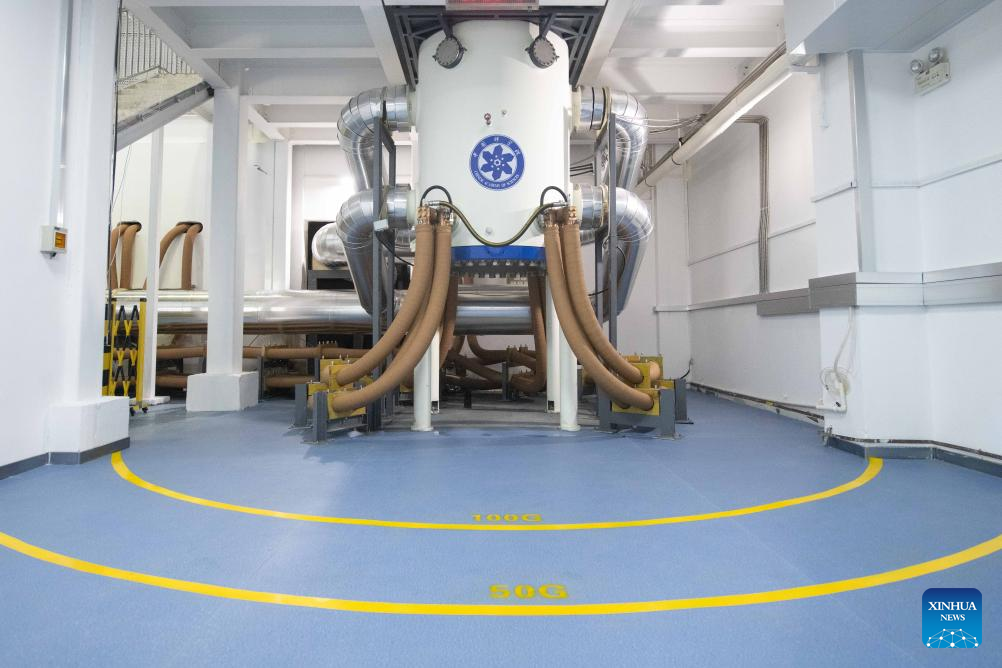Xinhua | September 23, 2024
This photo taken on Sept. 22, 2024 shows the resistive magnet independently developed by Chinese scientists at the High Magnetic Field Laboratory of the Hefei Institutes of Physical Science under the Chinese Academy of Sciences (CHMFL) in Hefei, east China's Anhui Province. (Xinhua/Zhang Duan)
Chinese scientists used an independently developed resistive magnet on Sunday to produce a steady magnetic field of 42.02 tesla, equivalent to over 800,000 times the Earth's magnetic field, breaking a world record set by the United States in this field in 2017.
The milestone achievement made by the High Magnetic Field Laboratory of the Hefei Institutes of Physical Science under the Chinese Academy of Sciences (CHMFL) is expected to drive scientific discoveries and applications in a wide range of technological fields.
The steady high magnetic field is an extreme experimental condition, serving as a powerful tool for scientific research. In the experimental environment of a high magnetic field, the properties of matter can be manipulated, which is conducive to scientists discovering new phenomena and exploring new laws of matter, experts explained.
High magnetic fields can also give rise to new application technologies, such as electromagnetic metallurgy and chemical reaction synthesis, and especially the widespread utilization of nuclear magnetic resonance technology in medical science.
Due to its significant value in various fields such as physics, chemistry, material science and life science, the steady high magnetic field is referred to as the "cradle" of the Nobel Prizes.
The new achievement results from nearly four years of efforts by the research team, which involved innovating magnetic structures and optimizing manufacturing processes, said Kuang Guangli, academic director of CHMFL.
Kuang said this breakthrough could meet users' needs for a fast, regulated and stable high magnetic field, provide scientists with powerful experimental conditions, and lay a key technological foundation for China's construction of higher-field steady magnets.
Five major steady high magnetic field laboratories are located in the United States, France, the Netherlands, Japan and China.
As one of China's major items of scientific and technological infrastructure, the steady high magnetic field facility in Hefei, east China's Anhui Province, went into operation in 2017. Chinese scientists produced the world's highest steady magnetic field of 45.22 tesla by using a hybrid magnet at the facility in 2022.
Steady high magnetic field magnets include resistive magnets, superconducting magnets and hybrid magnets. According to experts, resistive magnets have the advantage of flexible and quick control, providing reliable and efficient experimental conditions for scientific research.
Kuang likened resistive magnets and superconducting magnets to singles players in table tennis and hybrid magnets to mixed doubles players. "After winning the mixed doubles championship in 2022, our team has now also claimed a singles championship," said Kuang.
China's steady high magnetic field facility has provided experimental conditions for more than 197 domestic and international institutions, including Tsinghua University, Peking University, the University of Science and Technology of China, and Harvard University. These users have carried out cutting-edge research in the fields of physics, chemistry, materials, engineering, life and health.
With the help of the facility, scientists have uncovered the molecular and neural mechanisms of enhancing learning and memory by exposure to sunlight, as well as developing drug candidates for targeted cancer therapy, non-alcoholic fatty liver disease and diabetes.
Kuang said that the team plans to develop new steady magnets to support the development of new electronic materials, explore the mechanisms and applications of high-temperature superconductivity, study the pathology of major diseases and related drugs, and produce high-performance semiconductor materials.




